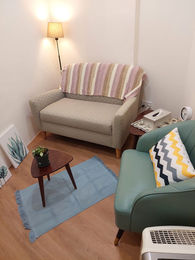
Art Therapy
Art therapy is of form of psychotherapy that encourages the expression of emotions and thoughts through art-making, facilitated by a certified art therapist.
It is especially useful for helping individuals process and verbalise difficult feelings, such as with persons dealing with trauma. Art therapy can also be part of a programme for children with behavioural or learning difficulties, allowing them to express themselves in a non-verbal way and developing healthy habits like impulse-control and self-regulation.
$200/hr
1
A gentle therapy approach
Most people consider making art a 'fun' activity. It can take away the intimidating feeling of 'going to therapy' and instead make one feel as if they are just embarking on a relaxing activity.
2
Where words fail, art speaks
Art engages the right hemisphere of the brain to illicit memories, sensory information and emotions, unlocking difficult thoughts associated with past events and trauma. This is necessary for processing emotions and achieving healing.
3
One therapy,
many uses
Art therapy can be used to treat a variety of mental health conditions (depression, PTSD), emotional difficulties (stress, family issues), and some neurological conditions (brain injury).
What does an art therapy session look like?
Every art therapy session may look a little different, but they usually involve a combination of art-making and talking with the therapist. The art therapist may give you some prompts or ask if you want to speak about anything before you proceed to make some art. As you pick up the art materials and begin, you are encouraged to let go of any expectations and fears, focusing on being in the moment and getting in touch with your feelings. Art therapy will feel different for every person. You may find yourself becoming more reflective, and your feelings may deepen and intensify as you become more conscious of them. The art therapist is there to guide you to think about these feelings and talk about them. Whether you are facing grief, anxiety, or frustrations, this session is for you to face them and process them with your therapist in a safe and constructive way.
Is art therapy for me?
Art therapy is often used in conjunction with other psychotherapy techniques, and can be used to treat a variety of mental health conditions, emotional difficulties, and some neurological conditions. As such, art therapy can benefit persons with: •Post-traumatic stress disorder (PTSD) or other trauma-related psychological issues •Learning disabilities (children) •Behavioural issues (children) •Depression •Anxiety •Stress or other emotional difficulties •Brain injury You do not have to be suffering from a diagnosed mental health condition to benefit from art therapy. Art therapy may also benefit you if you wish to explore your own emotions, and seek healing and growth from past issues like family troubles, self-esteem issues, or even existential questions.
Do I need to have artistic skills to do art therapy?
The session focuses on the process of art-making, and not the final product. Therefore, no prior art-making experience is required. It is a non-judgmental approach that seeks to empower the participant. We celebrate small successes.
What type of art is used in art therapy?
It can range from pencils, markers, and oil pastels to watercolors, ink, acrylic, clay, as well as yarn, fabric, and collage to name a few. Everyone responds differently to any given art material and different art materials will be used at different junctures to support the client through the therapy journey.
What is the role of an art therapist?
An art therapist who is present and attuned to the client can create a safe therapeutic space for exploratory and spontaneous creative play. She serves to witness, hold and contain the client’s pain. She will journey with the client, according to his or her pace to process certain aspects of the client’s life. Art therapy may enhance the acceptance of the self, and of others, bringing forth a new mindset of letting go, and performing closures while one tries to live a meaningful life. This may lead to insights, which may in turn lead to reconciliation and the restorative identity of the self and client’s relationships.
Is art therapy and art jamming the same?
No. The focus of art jamming or art & crafts is more on the end product whereas an art therapy session led by an art psychotherapist is focused on the process of guiding clients towards forming their own insights. The client takes the lead towards self-discovery through the process of art-making. Art therapy can be conducted at a lighter supportive level or a deeper insight-oriented psychodynamic level depending on the needs of each participant.
Can the art therapist interpret my art?
Participants interpret their own artworks most of the time. The art psychotherapist will facilitate. Art therapy is a recognised mental health profession and art therapists have to attain a Master in Art Therapy in order to practice.
“Art is my cure to all this madness, sadness and loss of belonging in the world & through it I'll walk myself home."
- Nikki Rowe




